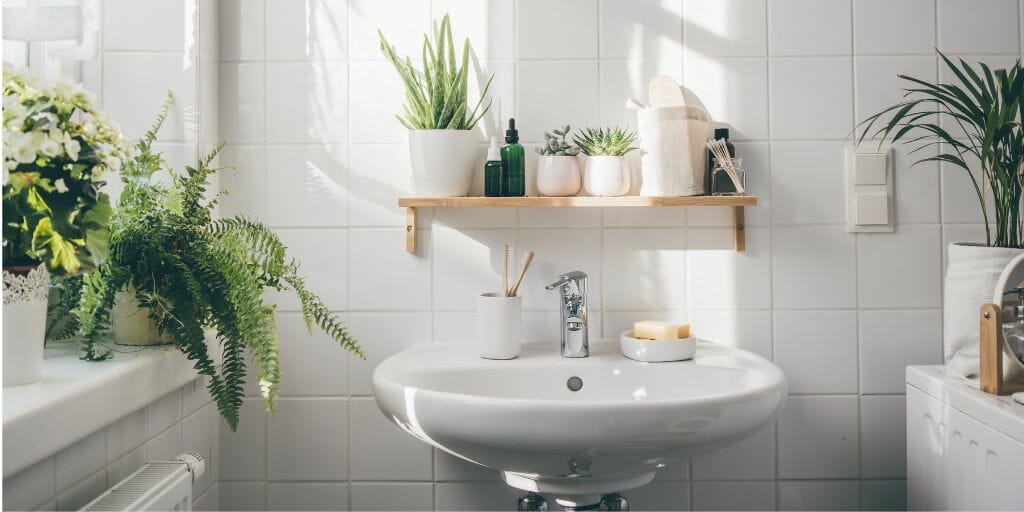Creating a bathroom that is accessible and safe for everyone is an essential aspect of home design, particularly when you factor in older adults. Whether you’re designing a bathroom for yourself, a family member, or simply planning for the future, incorporating accessibility features ensures comfort, safety, and allows for independence.
To help you, we’ve put together some of our top bathroom design tips for creating an accessible and safe space that doesn’t compromise on style.
Think about the layout
If you’re completely renovating your bathroom, take some time to consider the layout. Whilst this may not be possible depending on the size of the space you’re working with, try to ensure that there is ample room for manoeuvrability.
Aim for a spacious layout that accommodates walkers and limited mobility. You can also consider widening doorways to provide easier access.
Install grab bars or handrails
Installing grab bars and handrails strategically throughout the bathroom can greatly improve safety and stability. They should be securely mounted on the walls near the toilet, shower, and/or bath.
Opt for high-quality, slip-resistant bars that can bear substantial weight and provide a firm grip. Nowadays grab bars come in a variety of stylish designs so it’s easy to find one that matches the aesthetic you like. However, when picking a grab bar or handrail, it’s important to consider the material they’re made of, particularly in a damp bathroom environment. Aim for a non-corrosive material like stainless steel which is durable and easy to maintain/clean. If gripping is an issue, you may want to consider using bars with a textured surface to add additional stability.
It is also vital to position them at the correct height in order for them to be effective. The height they need to be will vary depending on the individual and what they’re being used for, so it’s best to talk to a professional if you’re not sure about where to install them.
Flooring and surfaces
Selecting the right flooring material is crucial for creating a safe bathroom. Choose slip-resistant flooring options like ceramic tiles, vinyl, or rubber flooring that provide good traction and reduce the risk of falls. Avoid materials like polished marble or tiles as they can become very slippery when wet. It’s important that you ensure flooring is properly installed, with no loose or uneven tiles that could pose a tripping hazard. It’s best to get a professional like us to assist with this if you’re not confident in your DIY skills.
You should also place non-slip bathmats or rugs near the shower, bath, and basin areas. These mats should have a non-skid backing to prevent slipping and sliding, if they don’t, you can use specifically designed tape to ensure they stay stuck to the floor. Invest in some sturdy non-slip mats or textured tiles to go in the shower or bath too as these are some of the biggest bathroom slip risks.
Fixtures and features
When looking at what fixtures and features you want in your bathroom, make sure your focus is on accessibility. For example, consider installing a raised toilet seat or a comfort-height toilet to make it easier for older adults with mobility challenges to sit down and stand up.
You can also install taps that can be easily operated with one hand or require minimal effort to turn. This is particularly useful for individuals with arthritis or joint pain that struggle to grip and twist.
Lighting and visibility
Proper lighting is essential for ensuring clear visibility and preventing accidents. You can use a combination of general and task lighting to ensure adequate light. You may want to consider installing motion-activated lighting that provide automatic lighting when someone enters the bathroom.
Choose a shower instead of a bath
For obvious reasons, if you struggle with mobility, a shower is a better option than a bath. If space permits, installing a walk-in shower with a level entry eliminates the need for stepping over a high bath wall. We regularly install fold-down seats in showering areas as these make it easier to safely and comfortably wash without the risk of slipping.
Whilst baths with doors can be an option for those who prefer baths, they do have some drawbacks you must consider. If you have a bath with a door, you must be in the bath with the door shut before you can begin filling it. This makes it difficult to accurately judge the temperature, increasing the risk of burns. You also must wait for the bath to empty before you can get out, which often means you’ll be sitting there getting cold whilst the water drains. For this reason, we always recommend opting for a shower with a fold-down seat installed instead.
Want help making your bathroom more accessible and safer? Contact us today and talk to our friendly team of experts who can discuss your options with you and make recommendations.

